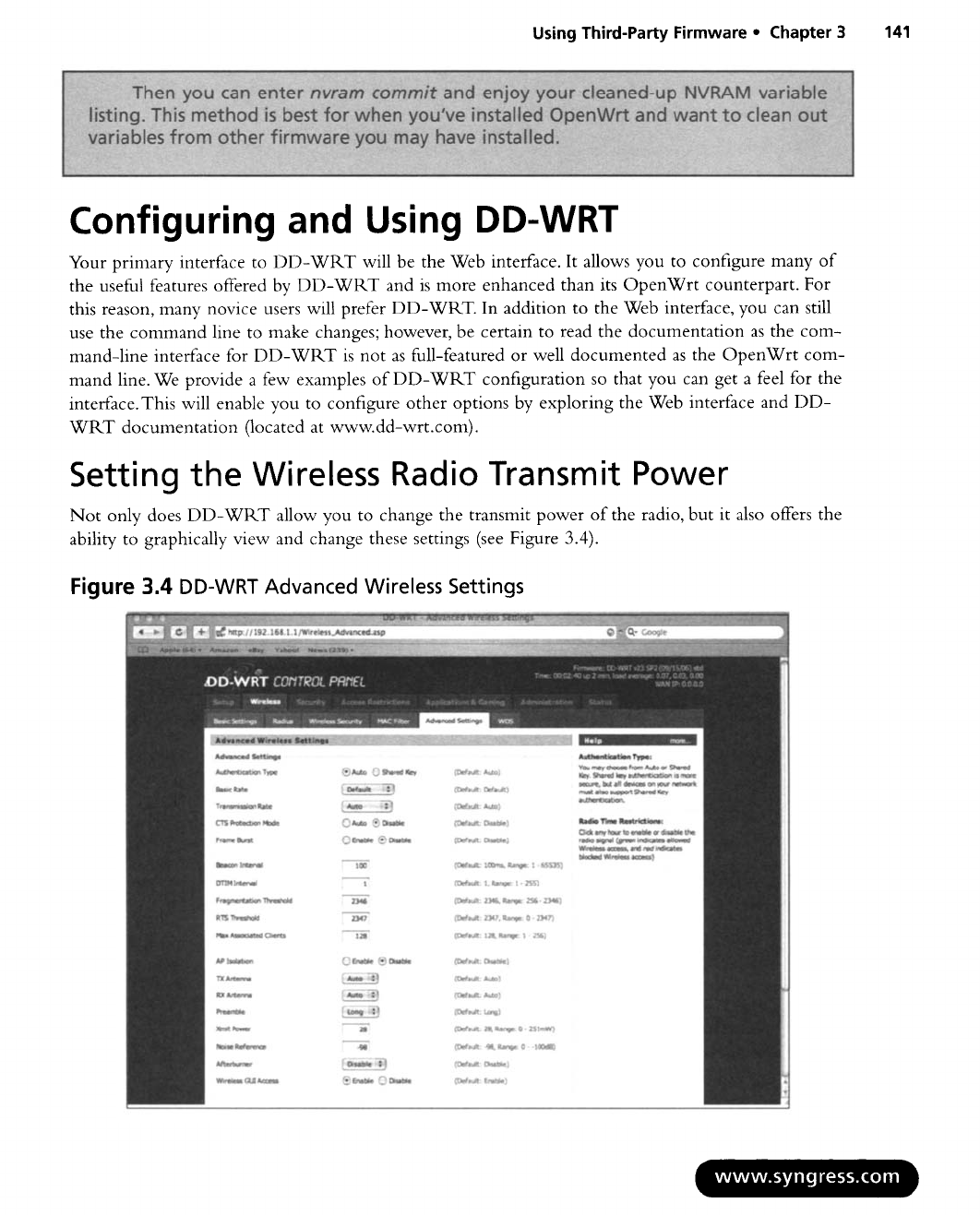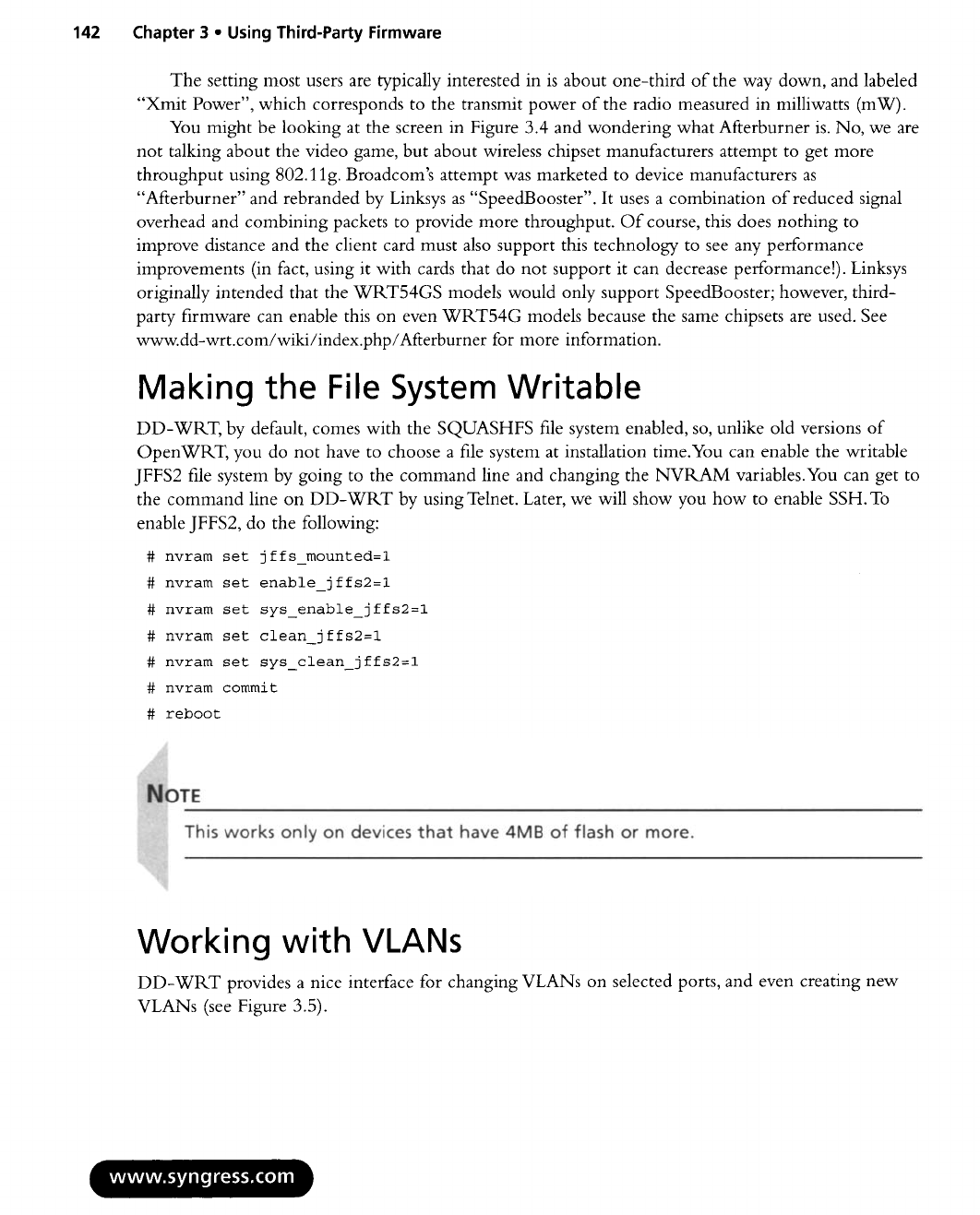
Using Third-Party Firmware • Chapter 3 141
Configuring and Using DD-WRT
Your primary interface to DD-WRT will be the Web interface. It allows you to configure many of
the useful features offered by DD-WRT and is more enhanced than its OpenWrt counterpart. For
this reason, many novice users will prefer DD-WRT. In addition to the Web interface, you can still
use the command line to make changes; however, be certain to read the documentation as the com-
mand-line interface for DD-WRT is not as full-featured or well documented as the OpenWrt com-
mand line. We provide a few examples of DD-WRT configuration so that you can get a feel for the
interface. This will enable you to configure other options by exploring the Web interface and DD-
WRT documentation (located at www.dd-wrt.com).
Setting the Wireless Radio Transmit Power
Not only does DD-WRT allow you to change the transmit power of the radio, but it also offers the
ability to graphically view and change these settings (see Figure 3.4).
Figure 3.4 DD-WRT Advanced Wireless Settings
/ / Z92 ~:168,1,2
tWtreless_Advanced:asp
A,~he~ica~ T~
Tra:r~o"~i~o~
Rate
i
~M interval
i
Fra~m~r~ti~
Ttv~i'~,Idi
~28
~i~ Power" 2B ~
.......................
.................................................................................................... A~tkml~qN:
Y~ ~ ~ ~ A~o or ~red
secure, ~a~) ~ces or~ ~o~ net~d¢
at£n~.ir.ation,
www.syngress.com

142 Chapter 3
•
Using Third-Party Firmware
The setting most users are typically interested in is about one-third of the way down, and labeled
"Xmit Power", which corresponds to the transmit power of the radio measured in milliwatts (mW).
You might be looking at the screen in Figure 3.4 and wondering what Afterburner is. No, we are
not talking about the video game, but about wireless chipset manufacturers attempt to get more
throughput using 802.1 lg. Broadcom's attempt was marketed to device manufacturers as
"Afterburner" and rebranded by Linksys as "SpeedBooster". It uses a combination of reduced signal
overhead and combining packets to provide more throughput. Of course, this does nothing to
improve distance and the client card must also support this technology to see any performance
improvements (in fact, using it with cards that do not support it can decrease performance!). Linksys
originally intended that the WRT54GS models would only support SpeedBooster; however, third-
party firmware can enable this on even WRT54G models because the same chipsets are used. See
www.dd-wrt.com/wiki/index.php/Afterburner for more information.
Making the File System Writable
DD-WRT, by default, comes with the SQUASHFS file system enabled, so, unlike old versions of
OpenW1KT, you do not have to choose a file system at installation time.You can enable the writable
JFFS2 file system by going to the command line and changing the NVRAM variables.You can get to
the command line on DD-WRT by using Telnet. Later, we will show you how to enable SSH. To
enable JFFS2, do the following:
# nvram set j ffs_mounted=l
# nvram set enable_jffs2=l
# nvram set sys_enable_jffs2=l
# nvram set clean_jffs2=l
# nvram set sys_clean_jffs2=l
# nvram commit
# reboot
.... ~
iili!iNli
This works only on devices that have
4MB of flash or
more.
.... ~:
Working with VLANs
DD-WRT provides a nice interface for changing VLANs on selected ports, and even creating new
VLANs (see Figure 3.5).
Get Linksys WRT54G Ultimate Hacking now with the O’Reilly learning platform.
O’Reilly members experience books, live events, courses curated by job role, and more from O’Reilly and nearly 200 top publishers.

